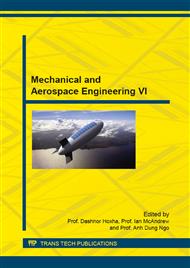p.276
p.282
p.287
p.292
p.297
p.303
p.308
p.314
p.319
Stability Analysis of the Microsatellite Attitude Control System
Abstract:
The problem of development of the microsatellite attitude control system on the base of reaction wheels positioned along its principal central axes of inertia is considered in this article. As difference from the classical mathematical models describing the microsatellite motion, this article includes the mathematical model of reaction wheel which is controlled by the input voltage of the electric motor. PD-controller is used as the basis for the development of the control law for microsatellite attitude. The stability analysis of the microsatellite attitude control process was carried out with the help of Lyapunov function method. This analysis allowed to prove that obtained attitude control law provides the asymptotic stability of the microsatellite rotational motion. Further, the function of control voltage for the reaction wheel’s electric motor with account of its technical specifications was obtained based on the derived mathematical model of the reaction wheel’s dynamics. The results of performed simulation showed the effectiveness of developed control. Obtained results of the study provide a base for the use of presented approach to the development of attitude control system for microsatellites with various missions.
Info:
Periodical:
Pages:
297-302
Citation:
Online since:
October 2015
Price:
Сopyright:
© 2015 Trans Tech Publications Ltd. All Rights Reserved
Share:
Citation:


